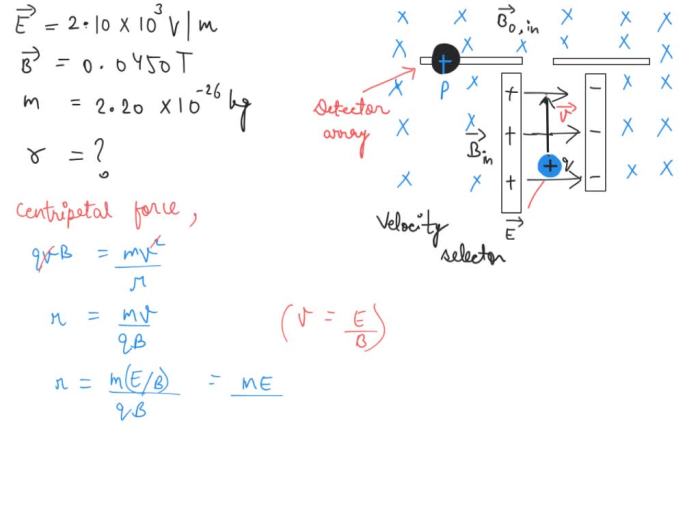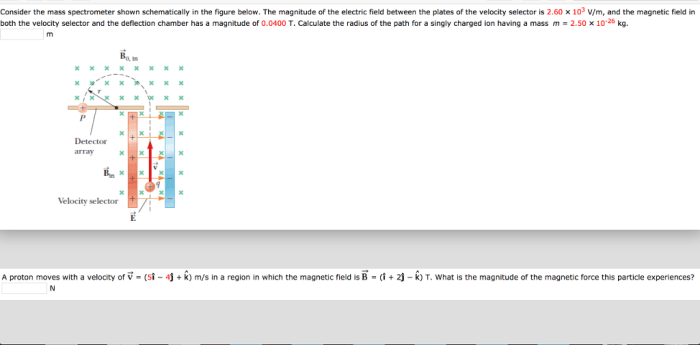Consider the mass spectrometer shown schematically – Consider the mass spectrometer, a remarkable analytical tool that has revolutionized our understanding of matter. This sophisticated device, with its intricate components and sophisticated techniques, empowers scientists to unravel the complexities of molecules, unlocking a wealth of information about their composition, structure, and properties.
The mass spectrometer, a cornerstone of modern analytical chemistry, has found widespread applications in diverse fields, ranging from drug discovery and environmental monitoring to forensic investigations and materials science. Its ability to identify, quantify, and characterize compounds with unparalleled precision has made it an indispensable tool for researchers and practitioners alike.
Introduction
Mass spectrometry is an analytical technique that measures the mass-to-charge ratio of ions. It is used to identify, characterize, and quantify various compounds in a sample. Mass spectrometry has a wide range of applications in various fields, including analytical chemistry, biochemistry, environmental science, and forensic science.
A mass spectrometer consists of an ion source, a mass analyzer, and a detector. The ion source ionizes the sample molecules, the mass analyzer separates the ions based on their mass-to-charge ratio, and the detector measures the abundance of each ion.
Schematic Diagram of a Mass Spectrometer

The following is a schematic diagram of a mass spectrometer:
- Ion source:The ion source ionizes the sample molecules. There are different types of ion sources, including electron ionization (EI), chemical ionization (CI), and electrospray ionization (ESI).
- Mass analyzer:The mass analyzer separates the ions based on their mass-to-charge ratio. There are different types of mass analyzers, including quadrupole mass analyzers, time-of-flight mass analyzers, and ion trap mass analyzers.
- Detector:The detector measures the abundance of each ion. There are different types of detectors, including electron multipliers, Faraday cups, and ion-counting detectors.
Ionization Methods

There are different ionization methods used in mass spectrometry. The choice of ionization method depends on the nature of the sample and the desired information.
- Electron ionization (EI):EI is a hard ionization method that produces ions with high internal energy. EI is often used for the analysis of small molecules.
- Chemical ionization (CI):CI is a softer ionization method that produces ions with lower internal energy. CI is often used for the analysis of large molecules.
- Electrospray ionization (ESI):ESI is a soft ionization method that is used for the analysis of polar molecules. ESI is often used for the analysis of proteins and other biomolecules.
Mass Analyzers
There are different types of mass analyzers used in mass spectrometers. The choice of mass analyzer depends on the desired mass range, resolution, and sensitivity.
- Quadrupole mass analyzers:Quadrupole mass analyzers are the most common type of mass analyzer. They are relatively inexpensive and easy to operate. Quadrupole mass analyzers have a limited mass range and resolution.
- Time-of-flight mass analyzers (TOF):TOF mass analyzers measure the time it takes for ions to travel from the ion source to the detector. TOF mass analyzers have a high mass range and resolution. However, TOF mass analyzers are more expensive and complex to operate than quadrupole mass analyzers.
- Ion trap mass analyzers:Ion trap mass analyzers trap ions in a three-dimensional space. Ion trap mass analyzers have a high mass range and resolution. However, ion trap mass analyzers are more expensive and complex to operate than quadrupole mass analyzers.
Detectors: Consider The Mass Spectrometer Shown Schematically

There are different types of detectors used in mass spectrometers. The choice of detector depends on the desired sensitivity and selectivity.
- Electron multipliers:Electron multipliers are the most common type of detector used in mass spectrometers. They are sensitive and have a wide dynamic range.
- Faraday cups:Faraday cups are less sensitive than electron multipliers, but they are more rugged and have a wider dynamic range.
- Ion-counting detectors:Ion-counting detectors are the most sensitive type of detector used in mass spectrometers. They are used for the analysis of low-abundance ions.
Data Analysis
The data from a mass spectrometer is analyzed using software. The software converts the raw data into a mass spectrum. A mass spectrum is a plot of the abundance of each ion versus its mass-to-charge ratio.
The mass spectrum can be used to identify and characterize the compounds in a sample. The software can also be used to quantify the compounds in a sample.
Applications of Mass Spectrometry

Mass spectrometry has a wide range of applications in various fields, including:
- Analytical chemistry:Mass spectrometry is used to identify and quantify compounds in a variety of samples, such as food, drugs, and environmental samples.
- Biochemistry:Mass spectrometry is used to study the structure and function of proteins and other biomolecules.
- Environmental science:Mass spectrometry is used to monitor pollutants in the environment.
- Forensic science:Mass spectrometry is used to identify drugs, explosives, and other materials in forensic investigations.
Questions and Answers
What is the basic principle behind mass spectrometry?
Mass spectrometry separates ions based on their mass-to-charge ratio, allowing for the identification and characterization of molecules.
What are the different ionization methods used in mass spectrometry?
Common ionization methods include electron ionization, chemical ionization, electrospray ionization, and matrix-assisted laser desorption ionization.
What types of mass analyzers are commonly used in mass spectrometers?
Mass analyzers include quadrupole mass filters, time-of-flight analyzers, ion traps, and Fourier transform ion cyclotron resonance analyzers.